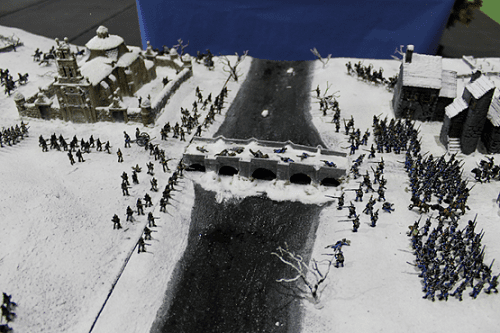Date 3 January 1809 | Result British victory | |
 | ||
200 men killed or wounded 200 men killed or wounded Similar Peninsular War, Battle of Cardedeu, Siege of Roses, Battle of Castellón, Battle of Benavente | ||
The Battle of Cacabelos was a minor battle of the Peninsular War that took place on 3 January 1809, at the bridge just outside the village of Cacabelos, Province of León, Spain, as Sir John Moore's British army was making its retreat to A Coruña. The French cavalry Brigadier General Auguste François-Marie de Colbert-Chabanais was killed by a sharpshooter at Cacabelos.
Contents
Geography
The village, on a plain in the mountainous region 15 kilometres (9.3 mi) past Ponferrada on the road from Astorga to La Coruña, is in the line of retreat taken by Moore's army to A Coruña, and its double arch stone bridge crosses the river Cua, a tributary of the Sil.
Battle
Moore, who was camped at Villafranca, half a day's march away in the direction of A Coruña, had ridden back to see Edward Paget who, just a few days previously, had led a successful cavalry clash at Benavente. The rearguard of Moore's troops, having arrived at Cacabelos the previous day, and delayed by the effects of rioting and the severe cold, was preparing to cross the bridge, when the 15th Hussars informed Paget that French cavalry units were rapidly approaching from Ponferrada. Soon, between 450 and 500 troopers of the 15eme Chasseurs à Cheval and 3eme Hussards, Marshal Nicolas Soult's advance guard, led by Brigadier General Auguste François-Marie de Colbert-Chabanais caught up with the tail end of the army, capturing around 50 British soldiers caught by surprise.
Deciding to press his advantage, and without waiting for infantry or artillery support, Colbert prepared to attack the bridge. However, on seeing the 95th Rifles, the 28th Foot, and six guns of the Royal Horse Artillery in position on the other side of the bridge, Colbert withdrew his men to reform them in a column of fours prior to rushing the bridge.
Moore, meanwhile, who had almost been captured by Colbert's men, looked on from the western hill above the road, with Paget.
When La Houssaye's cavalry and infantry support arrived they tried to cross the river by a ford a short distance downstream from the bridge and Merle’s infantry division tried to take the bridge "a la baionette". By around 4.00pm it was too dark to continue and the French troops, possibly considering the British troops' defensive position too good, and also possibly low in morale due to the death of Colbert, desisted. At about 10.00pm, Paget was able to set off towards Villafranca with no sign of French troops in pursuit.
Plunket's Shot
Colbert-Chabanais was killed by a single long-range shot from a Baker rifle, fired by a noted sharpshooter of the 95th Rifles, rifleman Thomas Plunket, and who also, with a second shot, killed the officer who came to Colbert's assistance. Although there is much discrepancy regarding the distances involved, the shot has been claimed to have been as far as 600 metres, it's highly likely that Colbert considered himself well beyond the musket range of 80 metres and therefore safe, whereas the Baker had verified target accuracy of 200 metres.
Consequences
Although British troops gained time in their retreat towards La Coruña, Moore has since been criticised for being too hasty in his retreat and for not having made better use of strong defensive positions such as the one at Cacabelos.
